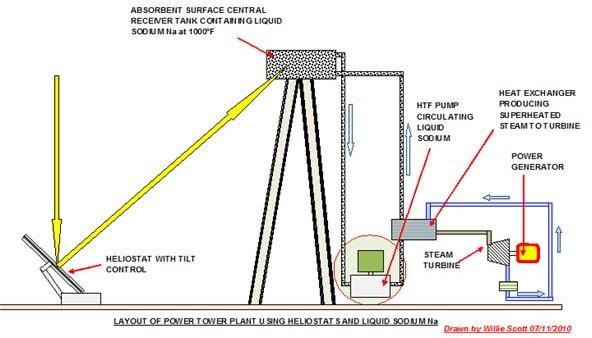HTF (Heat Transfer) Pumps for Concentrated Solar and large-tract Mirrored Receiver Power Plants
Introduction to HTF Pumps for Solar Installations - Design Criteria and Selection
Heat transfer pumps (HTF) must be capable of pumping a variety of high temperature and pressure heating mediums around a solar power installation.
The popular mediums are synthetic oil for Cylindrical Parabolic Receivers and molten salts for a Central Receiver and Solar Fresnel Linear Plants.
This is an article on heat transfer pumps, their specifications and operating parameters. Here we shall examine several pumps from different manufacturers; we begin then by having a quick look at the three different types of Concentrated Power systems in operation today.
Concentrated Solar Power (CSP) Systems – an Overview
There are three types of CSP systems.
1. Solar Power Plant with a Central Receiver
This solar plant consists of numerous flat mirrored heliostats that automatically track the sun as it moves across the sky. They beam the reflected concentrated radiation to a central receiver fixed at a predetermined height on a tower.
The receiver normally holds molten salts that are a mixture of nitrates that convert easily to liquid and withstand the high temperatures required by the system.
The HTF pump circulates the salts from the receiver to a heat exchanger that uses this high temperature medium to convert water to superheated steam in a two pass process. The superheated steam is then used to drive the power generators.
2. Solar Parabolic Collector Power Plant
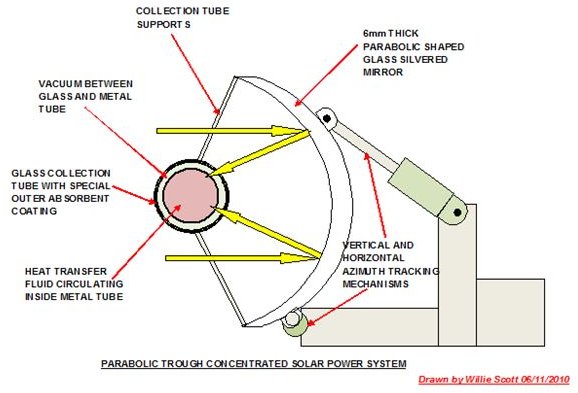
This type of solar power plant uses mirrored parabolic shaped troughs to track the sun across the sky and concentrate its radiation onto an integral metal tube, enclosed in a glass tube under a vacuum.
The HTF pump circulates the medium, usually synthetic oil, through numerous parabolic components, raising its temperature before feeding it through a heat exchanger. The heat exchanger converts water to superheated steam, which is used to run steam turbines and drive power generators.
3. Linear Solar Fresnel Power Plant
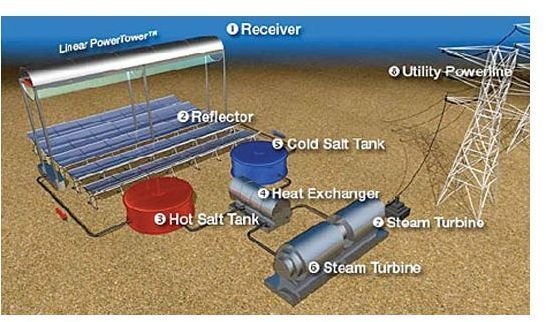
This solar power plant uses numerous linear mirrors to reflect the sun’s radiance onto a receiver tube, usually located above the array of linear mirrors. The HTF pump circulates molten salts from the receiver tube through a heat exchanger that converts water to superheated steam.
As with the other two CSP power plants, the superheated steam runs the turbines used to drive power generators.
Reference Webs:
HTF Pumps for Solar Installation – Design & Specification Criteria
The pumps are generally horizontal, but can also be of vertical design, being centrifugal, single, or multistage stage. They have durable stainless and/or duplex steel internals to match the sometimes abrasive and hazardous fluids, but they always handle high temperature and pressure to suit the medium that they circulate.
HTF pumps are specifically designed for the CSP power plants and as such have special seals, bearings, drive shafts, impellors, and casings.
Some solar installations have a main and auxiliary HTF pump, both built to meet the plant conditions. The main pump is located on the discharge from the panels to a tower receiver, with the auxiliary one being on the return line from the heat exchanger.
High Temperature Fluid Pumps must be fully compliant with ISO 13709/API 610. Some of the components encompassed are listed below:
- Pump casing and baseplate design and dimensions.
- Allowable nozzle loads.
- Pump impellors.
- Capacity, heads, temperature, and pressure
- Wear-ring diameters.
- Casing gaskets.
- Coupling guard.
- Ball and radial bearings.
- Shaft mechanical and gas seals.
- Seal chamber.
- Drive shafts.
- Vibration levels.
- Materials of construction.
- Net Positive Suction Head (NPSH).
The API 610 specifies the HTF pump design. Below are some HTF pump manufacturers design and operating parameters, along with images:
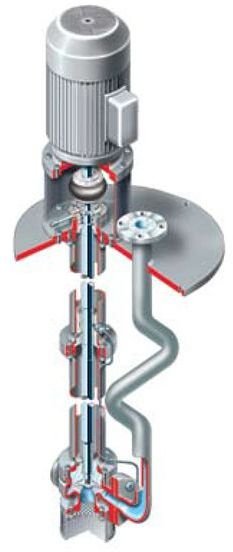
Vertical Turbine Pump
Operating Parameters
- Flowrate 13, 600 m3/hr / 60,000gall/min
- Heads 530 m / 740 ft •
- Pressures 100 bar / 1450 psi
- Temperatures 600°C /1100°F
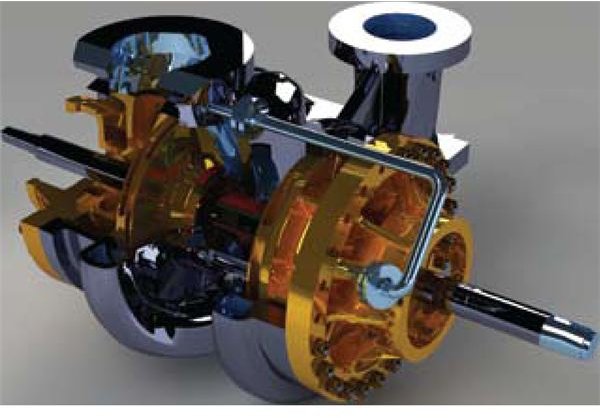
Parameters
- Temperatures to and above 400ºC
- Pressures of 100 bar and above
- Ready for heat transfer fluid (HTF)
- Equipped for variable speeds
- Suitable for 50 and 60 Hz applications
3. Sulzer Pumps

Parameters
- Temperatures 450 °C / 840 °F
- Flowrate 2600m3/hr / 11000 US Galls/hr
- Pressure 100bar / 1400psi
- Head 300m / 1000ft
- Core pump technologies in particular designed to handle fluids at temperatures of over 400°C whilst enduring extremely high and changing temperatures and pressures every day
Selection of a Heat Transfer Pump for a Solar Power Plant
The selection of the pump very much depends on it application and the type of CSP power plant it is to be used in.
Most of the horizontal centrifugal pumps can be designed to circulate oil or molten salts, but the vertical pumps are more suited to molten salts.
I have sailed as a ships engineer in charge of operating and maintenance of Sulzer marine engines and found them to be excellent source of main power. I have also worked as an engineer in the offshore oil and gas industry and installed Sulzer pumps to most of the production platforms fabricated at the offshore construction yard. Again there were good examples of engineering, and therefore I would be inclined to select a Sulzer HTF pump due to my personal experience of working with them.
Summary
Heat Transfer Pumps are used in Concentrated Solar Power plants to circulate a heating medium through receivers. These receivers are bombarded by the sun’s radiance reflected from parabolic or linear mirrors or from flat mirrored heliostats, depending on the system.
The medium is usually synthetic oil or molten salts and the HTF pumps have to cope with high temperature and pressures as well as high heads when circulating molten salts through a receiver fixed on a high solar tower.
High Temperature Fluid Pumps must be fully compliant with ISO 13709/API 610, both in their design and operating parameters.
This ensures that the Heat Transfer (HTF) Pumps for concentrated Solar and large-tract mirrored receivers are capable of pumping molten salts and synthetic oils at high temperature and pressures.
For information about concentrating solar power technologies, please see Dr. Harlan Bengtson’s four-part series here at Bright Hub.
